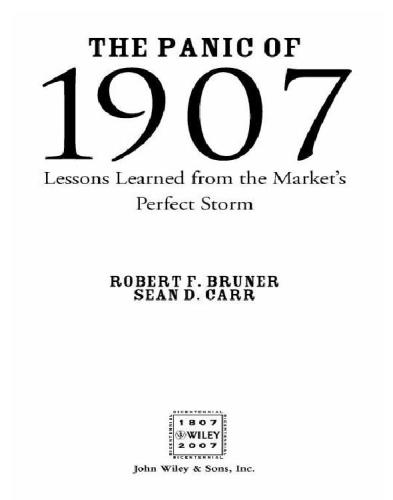
The Panic of 1907
Lessons Learned from the Market's Perfect Storm
کتاب های مرتبط
- اطلاعات
- نقد و بررسی
- دیدگاه کاربران
نقد و بررسی

July 30, 2007
Though business professors Bruner and Carr approach their subject, the spectacular financial crisis that gave America the FDIC and the Federal Reserve, with grave pedantry, they devote the majority of the book to the more colorful events and personalities of the crisis, which even academic prose cannot dull. The chronicle follows one speculator's attempt to corner the copper market, which leads to panic, the failure of banks and trusts and the impending bankruptcy of New York City. In the midst of chaos, one man was able to halt the domino effect with calm, character and capital: J. Pierpont Morgan. The Panic, the authors note, hit America at a moment eerily similar to our own: coming off 50 years of postwar economic expansion with a Republican "moralist" in the White House, an increasingly interventionist government, the formation of enormous new corporate conglomerates and a muckraking news media fueling resentment. Further, in a didactic final chapter, "Financial Crises as a Perfect Storm," the authors list the seven forces that, once converged, trigger alarm in investors, among them "buoyant growth," "inadequate safety buffers," "adverse leadership" and "undue fear, greed, and other aberrations"; that many (if not all) of these conditions are already met by today's market gives this authoritative history a relevance and vitality that should make business types sit up and take notice.

September 10, 2007
Though business professors Bruner and Carr approach their subject, the spectacular financial crisis that gave America the FDIC and the Federal Reserve, with grave pedantry, they devote the majority of the book to the more colorful events and personalities of the crisis, which even academic prose cannot dull. The chronicle follows one speculator's attempt to corner the copper market, which leads to panic, the failure of banks and trusts and the impending bankruptcy of New York City. In the midst of chaos, one man was able to halt the domino effect with calm, character and capital: J. Pierpont Morgan. The Panic, the authors note, hit America at a moment eerily similar to our own: coming off 50 years of postwar economic expansion with a Republican "moralist" in the White House, an increasingly interventionist government, the formation of enormous new corporate conglomerates and a muckraking news media fueling resentment. Further, in a didactic final chapter, "Financial Crises as a Perfect Storm," the authors list the seven forces that, once converged, trigger alarm in investors, among them "buoyant growth," "inadequate safety buffers," "adverse leadership" and "undue fear, greed, and other aberrations"; that many (if not all) of these conditions are already met by today's market gives this authoritative history a relevance and vitality that should make business types sit up and take notice.
Copyright 2007 Library Journal, LLC Used with permission.

























دیدگاه کاربران